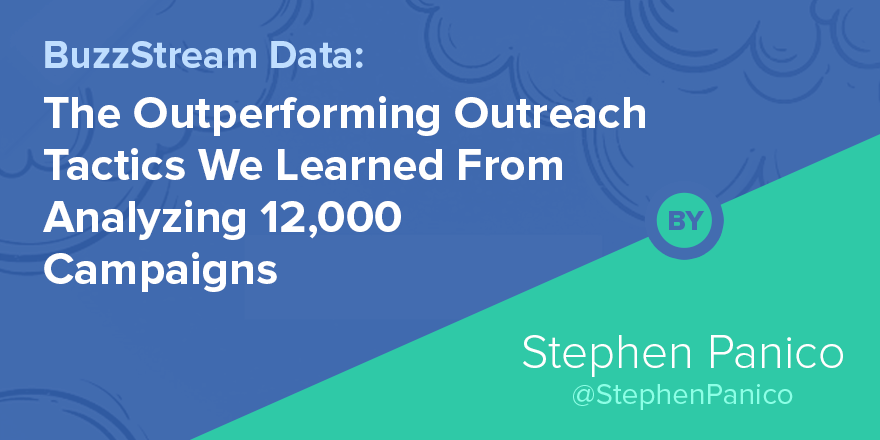
Outreach is at the heart of any strategy geared towards getting links, building buzz, or increasing brand awareness. Still, despite the fact that almost every company that cares about promoting their site or content sends outreach, there are tons of questions. Some of the ones we hear most often are:
- What level of response rates should we expect? How much variation should we expect from campaign to campaign?
- Do we need to personalize our outreach in order to get results? If so, how do we do this and still conduct outreach at a scale that moves the needle for the business?
- What can we do to improve our response rates?
To provide some answers to these questions, we’ve analyzed campaigns across our customer base to show what the baseline response rates look like and to determine whether (and how) certain organizations are able to consistently outperform the industry.
Spoiler alert: they are. And we’re going to show you the tactics that let them do it.
Key Takeaways
- The top 5% of groups conducting outreach are able to consistently get 40% or higher reply rates across their campaigns. This is dramatically higher than the median reply rate for companies we researched (12%). The primary differentiators for top performing accounts are the amount of time spent prospecting for highly relevant contacts and customizing messages to make them personalized and contextually relevant.
- Groups that send outreach using only templates with merge fields receive an average reply rate of 16%. Reply rates are decreased by -1.3% if a group personalizes in an irrelevant or cursory way, and boosted by an average of +10.7% for groups that contextualize those emails with relevant personalization. Groups that reference past promotion get a further boost of +2.3%.
Methodology
We aggregated outreach data from over 12,000 campaigns across 2,000 active BuzzStream accounts and analyzed it to understand reply rates by campaign. We then averaged the reply rates for all campaigns in a given account that have been completed over the past year. After that, we analyzed over 30,000 anonymized and coded individual emails to understand the impact of different approaches to outreach and personalization.
Finally, we followed up with top performing accounts (ie, those in the upper 5th percentile of campaign reply rate) to understand commonalities in their specific processes.
Overall Reply Rate Trends
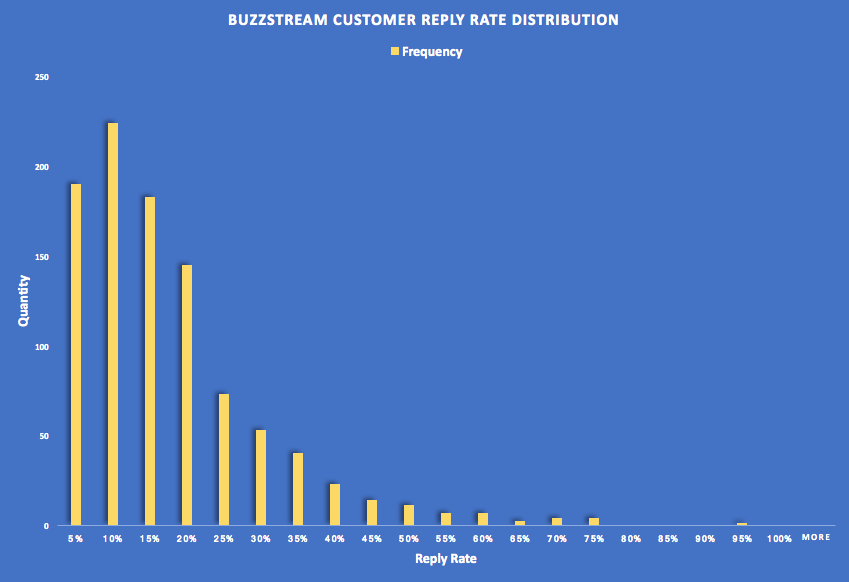
The most striking aspect of the data we analyzed is the sheer range of the distribution. Although the median reply rate hovers around 12%, there is a large chunk of our customer base that dramatically outperforms, with the upper 5th percentile averaging a staggering 40% reply rate across their campaigns.
Similarly, there are accounts that clearly do not perform well, with a comparatively paltry 3% reply rate across the campaigns we analyzed.
To quickly summarize the data:
- Roughly 50% of BuzzStream accounts regularly receive a reply rate of over 12% for their email campaigns
- The upper 25% of accounts regularly receive a 20% or higher reply rate
- The bottom 25% of accounts receive under a 7% reply rate
- The best performers (top 5%) receive reply rates of over 40%
- The worst performers (bottom 5%) receive under 3% reply rate
I should point out that this data covers the breadth of BuzzStream customers, which includes agencies and independent companies across a wide range of industries.
To discover the common success factors of top performing accounts, as well as elements that lead to underperforming campaigns, we examined the actual messages that were being sent to contacts across 12,000 campaigns.
What’s the Impact of Personalization on Reply Rates?
Of the campaigns we examined, the overwhelming majority (slightly over 95%) sent their initial outreach using a template with merge fields. When reviewing emails that were sent using only a template with merge fields, and no additional personalization, we saw a baseline reply rate of 16%.
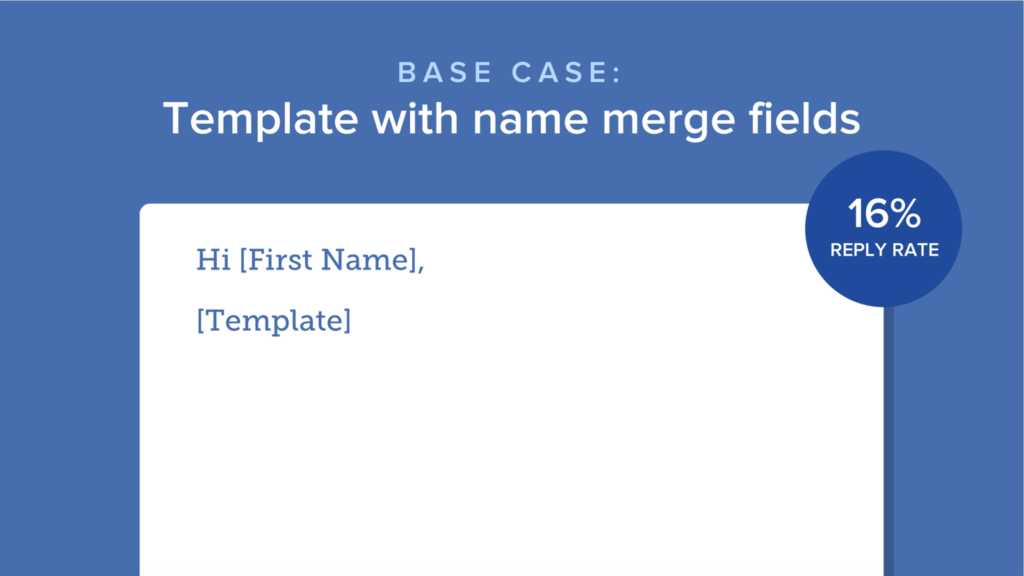
Once we knew the average base reply rate for people who did not personalize, we could assess the impact of different personalization strategies. Although personalization can be pretty diverse in its application, most of the messages we reviewed fit pretty snugly into three approaches:
- Fake personalization
- Contextual relevance
- Reference to past promotion
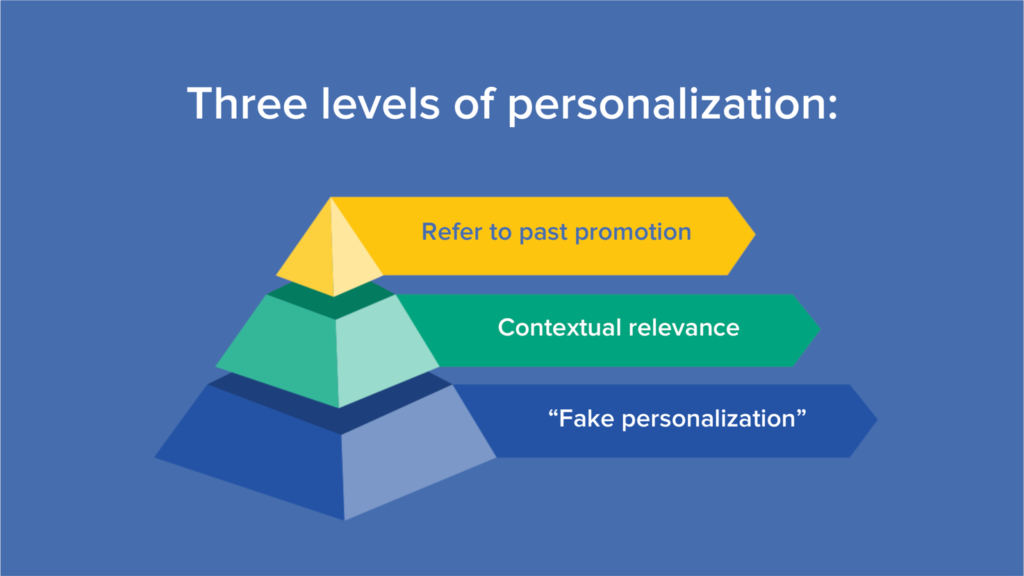
Fake Personalization
Fake personalization is named as such because it isn’t really personalization at all. Rather, it is a generic reference to an article or some other piece of information meant merely to signal that the outreach professional has some knowledge of the contact they are reaching out to, without actually having any context about that individual.
A common example of this type of outreach is any email that begins with some variation of:
“Hey FNAME, I just saw your article at XYZ.com. Great post! I’ve written something your audience would like…”
Unfortunately for those groups that utilize this process they’d be better served by not personalizing at all. Based on the data, fake personalization actually generates a -1.3% impact on reply rates compared to the base case of people only using templates with merge fields.
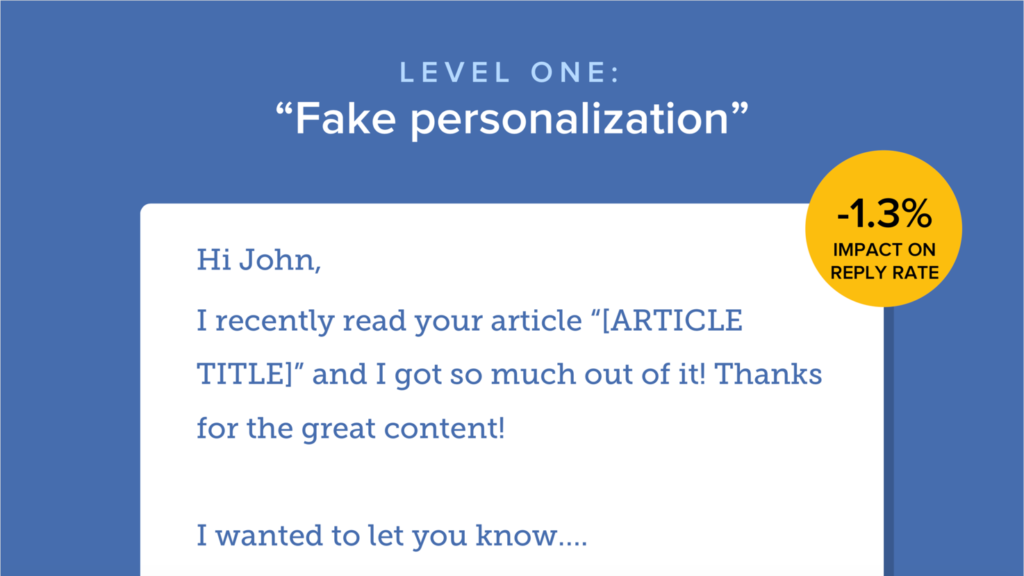
Contextual Relevance
Contextually relevant personalization shows clearly that the person sending outreach has a good understanding of the author by specifically referencing not just their article or info, but tying it directly into the ask. This type of personalization depends on a tight prospecting process as well as a good understanding of outreach audience.
This type of personalization, in stark contrast to fake personalization, offers significant improvements to the base case with an average reply rate improvement of +10.7%.
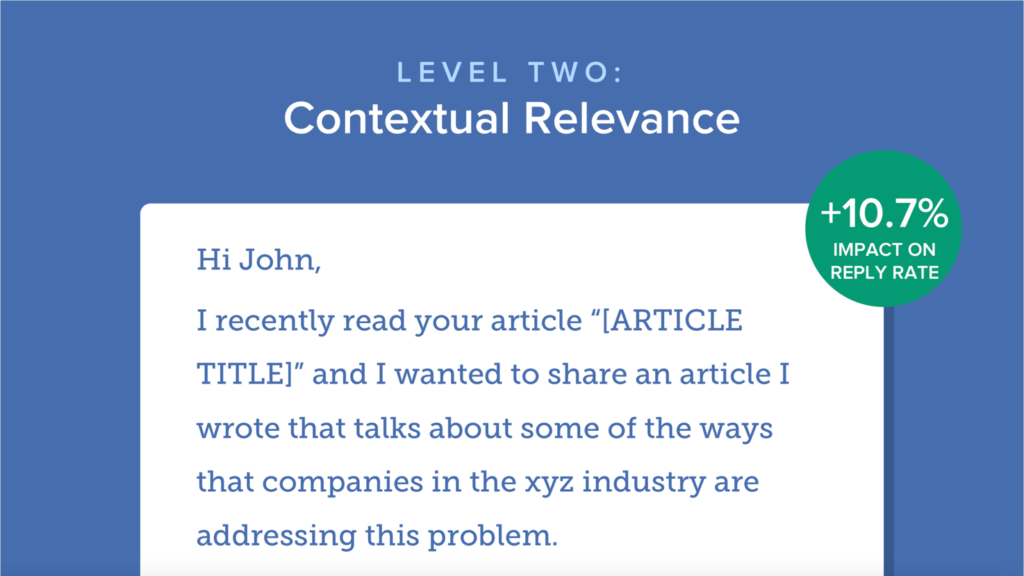
Refer to Past Promotion
References to past promotion are precisely what they sound like. This type of personalization requires a well-updated contact database that teams can reference in order to know which of the contacts in their campaigns have shared or linked in the past. If you’ve had a good working relationship in the past, that contact is much more likely to promote again.
However, when analyzing this type of personalization things get a little murky because it is almost always completed in concert with contextually relevant outreach. So, in order to isolate the average improvement of references to past promotion we analyzed those instances and compared them to those instances of contextual relevance without said references. When doing so, we found an average improvement of +2.3% on reply rate.
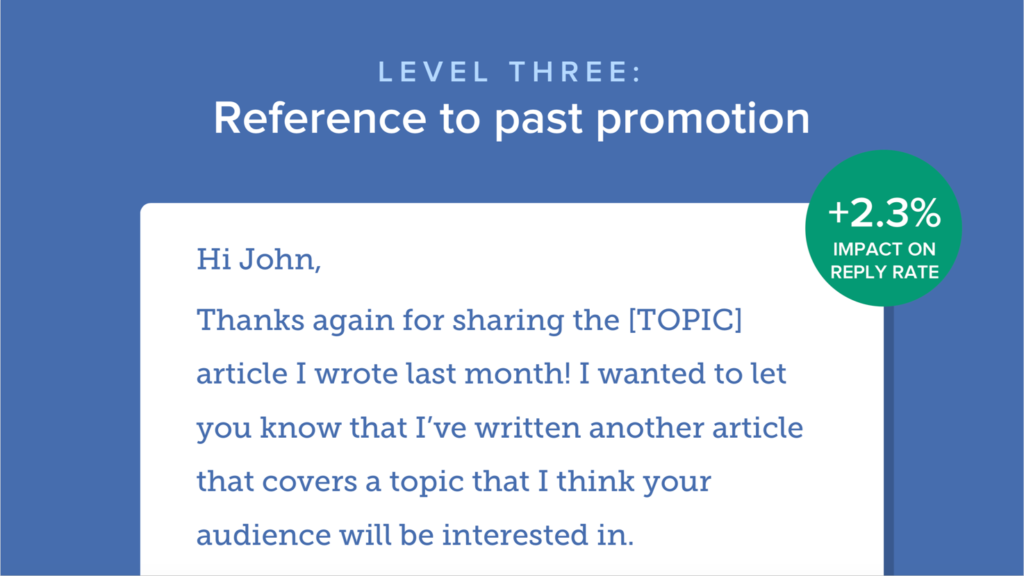
Campaign Results by Outreach Sender Type
When aggregating the types of outreach people are doing, there are 3 profiles that recur most often:
- Volume Senders – This group consists primarily of link builders who are primarily relying on links from specific page types to their content/site. They are mostly doing things like resource page outreach and link reclamation (unlinked mention) campaigns.
- SEO Content Marketers – This type of outreach team blurs the line between traditional SEO and PR, using a range of tactics including blogger outreach, infographic placement, broken link building.
- Pure Digital PRs – These accounts focus their outreach almost exclusively on high authority media sites by targeting journalists and high level influencers with exclusive and/or newsworthy content that aligns with their niche.
Although these approaches are nearly all aimed towards getting links to sites or content, the approaches differ significantly. To understand those, we reviewed the average list size, reply rate, average number of replies, and average Domain Authority of sites that replied.
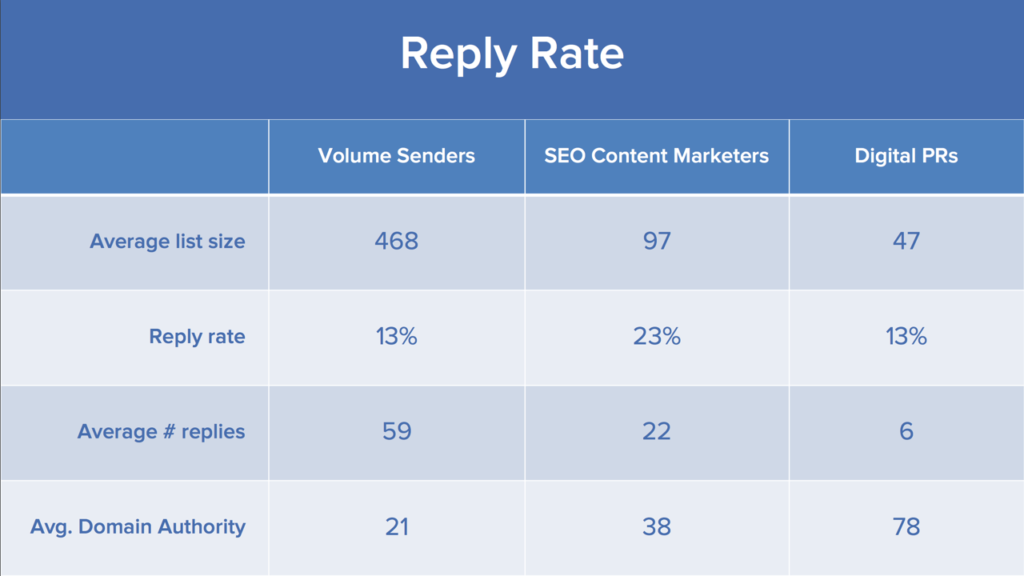
These strategies highlight significantly different campaign logistics, but an interesting (and slightly unexpected) element in the data was that Volume Senders and Digital PRs seem to get the same reply rate. It seemed like there was more to this story than was being told in the reply rate alone, so we turned to Ahrefs with a representative subset of these campaigns in order to understand the impact of these approaches on downstream placement rates.
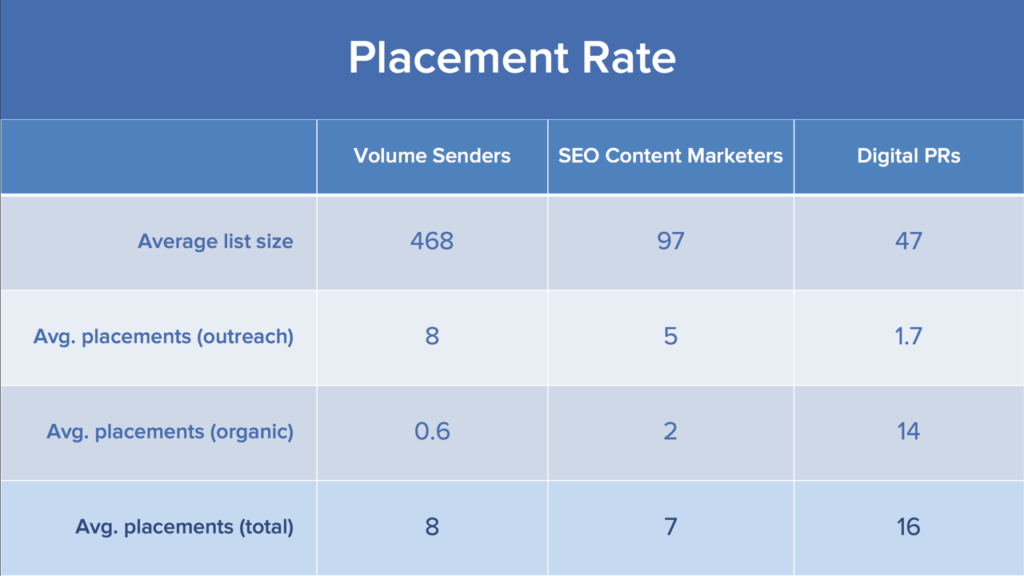
This analysis showed that although replies might be similar for two outreach types, actual placement rates differ significantly.
First, to clarify what we mean by “outreach” vs. “organic” links. Outreach placements are simply links that were earned as a direct result of outreach itself, whereas organic placements were earned as a result of people subsequently linking as a result of the impact of content or pages created by the contacts initially reached out to.
These results can be summed up as follows for each group:
- Volume Senders – Nearly all value of the outreach in terms of link placements is derived from the initial outreach itself. Due to the general lower authority of the sites and lack of editorial value for things like resource pages in general, there are fewer organic placements with this approach.
- SEO Content Marketers – A mixed bag, but shows that still the majority of value is derived from the initial outreach campaign. Subsequent organic links do happen, but it is not the backbone of the strategy because the range of authority and search value of those sites is scattered.
- Digital PR – Here, placement rates are very low in the initial outreach campaign, averaging one or two placements. However, because those sites are generally VERY high authority and the linking articles are often newsworthy based on current trends, subsequent organic links make up for the low initial placements.
Just to summarize the end impact of these different campaign approaches, here is the blended average placements and DAs for the different approaches:
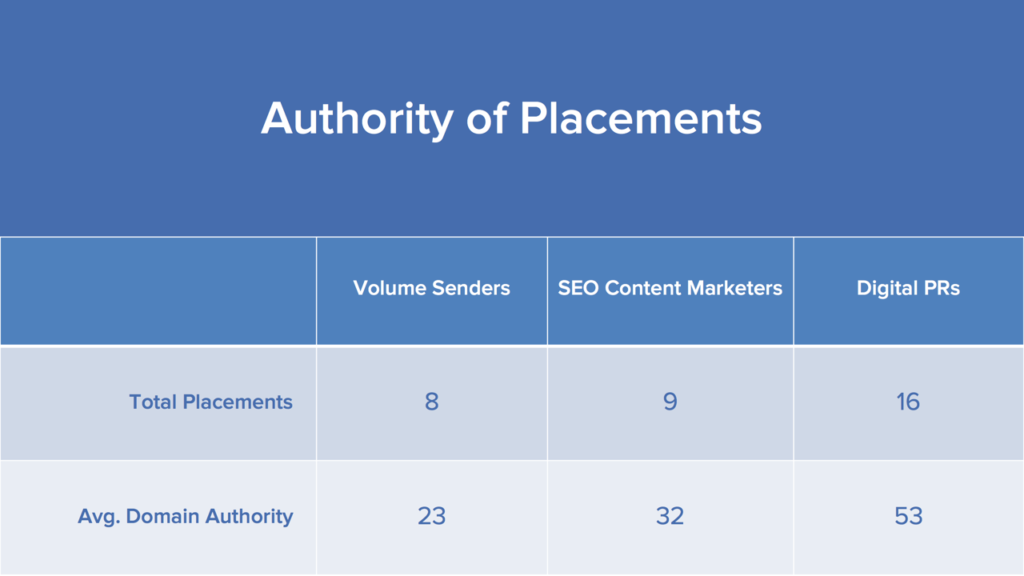
I should note that these results do not point to a superior outreach sending type. Although it appears that the better long term strategy is a pure Digital PR play, the reality is that each of these approaches have their place in an SEO strategy, and must be tied to the specific needs of the organization.
In a follow up piece I’ll explore more specifics around which of these processes to use and when to use them, but to just quickly review some of the pros and cons:
- Volume Senders – This process offers the fastest results and the most clear path to links. Further, it is the most consistent process because there is usual a very clear reason for the link request. That said, in general the authority of those sites is lower and subsequent links don’t generally happen.
- SEO Content Marketers – A blended approach that gets very solid authority links and builds relationships with niche influencers in a space. Done correctly, this approach will align closely with search intent and can also be used to establish an up and coming site as an authority in a vertical. However, it will be more difficult to earn links with this approach than in a volume sending campaign, and usually those links are not received from the most authoritative sites.
- Digital PR – This approach is all about targeted outreach to very high authority sites and is great for established brands or agencies that can offer proprietary data or exclusives to publications. These links get major buzz and, as we’ve seen, can lead to tons of follow on links themselves. However, this type of outreach can be difficult for brands or agencies that don’t already have a solid reputation, and often those publications will only be interested in exclusives. One other downside to this approach is that the primary benefit comes from increasing the authority of a site. However, it is not likely to result in a significant increase in page authority and may not get as much direct traffic value as the other approaches.
Trends of Top Performers
Given that there are teams that consistently get strong reply rates, we wanted to reach out to a few representative groups across the range of our customer base in the top 5% to understand the commonalities in their process. The goal here was to understand those elements not dependent on specific niche, industry, or team size.
Ultimately, the groups we talked to shared most of the following traits:
1. Process Oriented
These outreach teams have a well defined process and they stick with it. This does not necessarily mean that they structure their outreach rigidly, however. It means that they ensure that they find specific information about a contact, leverage this information in their emails, and follow up on replies and unread messages in an orderly manner. Many of these teams have scripted their processes so they can easily share them and onboard new team members as they grow.
“High touch outreach (at scale) is a unique blend between business processes and creative tasks. On one hand, having a set of efficient processes helps us stay organized and helps simplify the education process for new team members.
On the other hand, there’s a million ways you can customize an email, and a million directions the conversation can go in, so it’s more about teaching a way to think than it is about having strict templates to use. That’s why we have a library of outreach examples & utilize analytics tools to assess ongoing performance in order to maintain a high standard on outreach success rates.”
2. Significant Time Spent in Contact Prospecting
Probably the most common and significant differentiator of top performers. These groups spend the majority of their time prospecting, qualifying, and researching prospects to ensure they were going to be interested in their outreach.
“At Siege we like to make 100 percent sure that the people we’re reaching out to are a good fit for the piece we are pitching. We first review their site to make sure they are high quality and not loaded up with paid sponsorships or anything that feels remotely spammy.
We then determine how exactly the content we are pitching will be of interest to them. That means that for each prospect, we need to confirm the topical relevance and specific details of our piece that we think will interest them. For instance, maybe they’ve covered the same topic last year and ours has new data for this year.
The more time we spend vetting prospects and crafting our pitches up front, the easier and faster the outreach becomes.”
3. Customized Email Messaging to Each Contact
Simple to grasp, but perceived as difficult to execute, this was another common differentiator of top performers. In reality, the difficulty of customized messaging (meaning templates that are customized, not totally unique emails to each contact) is tied closely to time spent prospecting. The more time spent in the prospecting and segmentation phase, the easier it is to quickly personalize each message with relevant content.
“Some managers become so consumed in economies of scale, by proxy they end up devaluing the person who is on the receiving end of a pitch. However, when it comes to placements with high-authority publishers, taking the time to personalize each pitch is key to success. By scouring personal blogs, social media networks, and author archives, you establish knowledge that allows you to nurture an authentic relationship with each writer.
This long-term relationship-building strategy fosters name recognition and affinity for individuals on your team as well as your business. Over time, you’ll go from sending individual pitches to seeing top-tier writers reaching out to you for content and quotes.”
4. Leveraging Existing Relationships
Groups that have an established outreach program and a well-maintained contact database regularly leverage their relationships for future progress in two ways. First, as previously discussed, they will reference their relationships in their outreach to boost replies. Second, they will use their database as a source to build their lists for subsequent similar campaigns, building on the success of their campaigns and making results more beneficial and predictable over time.
“In our experience, targeting the right journalists is paramount – what makes a great story for a finance journalist looks very different to a great story for a travel journalist, in addition to writing a great pitch, you need to send it to the right people.
We use our database to help us build media lists based on similar successful campaigns, which enables us to be more targeted. Plus, as we frequently have multiple people working on the same campaign, (and multiple campaigns being promoted at the same time) it important for us to keep our database well maintained so we know whether or not a particular journalist has already been contacted about a campaign we’re working on.”

 End-to-end outreach workflow
End-to-end outreach workflow



 Check out the BuzzStream Podcast
Check out the BuzzStream Podcast








2 comments
Great content Stephen. This will really help with our outreach strategy. Keep it up
WOW Stephen, thanks for sharing! really appreciate it.
Cheers,
Christopher